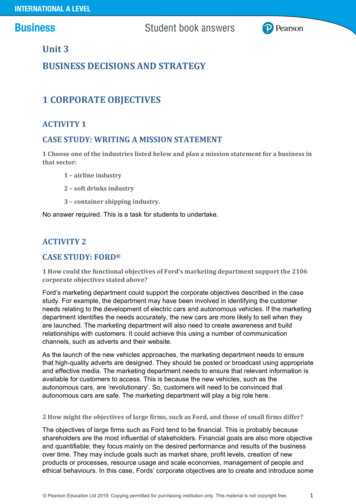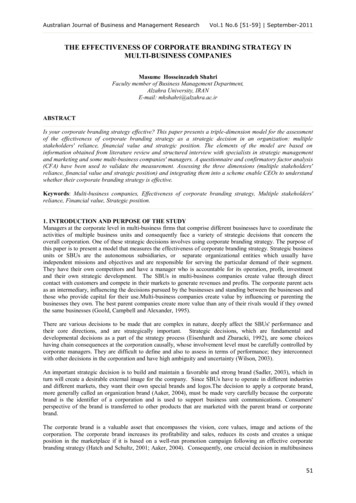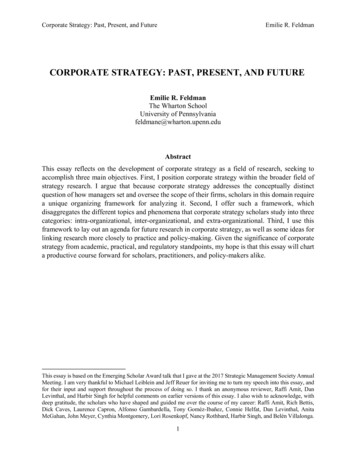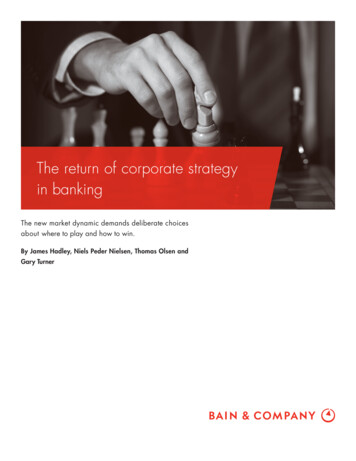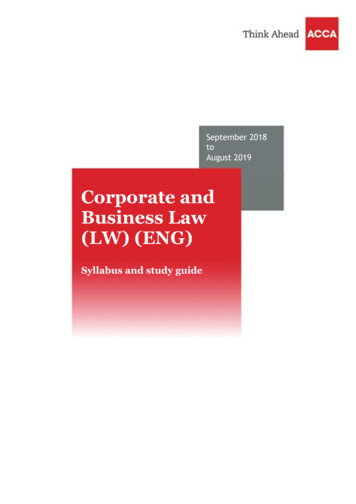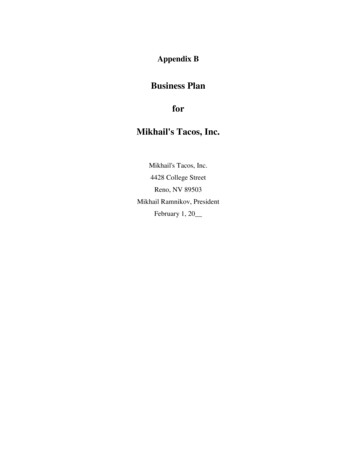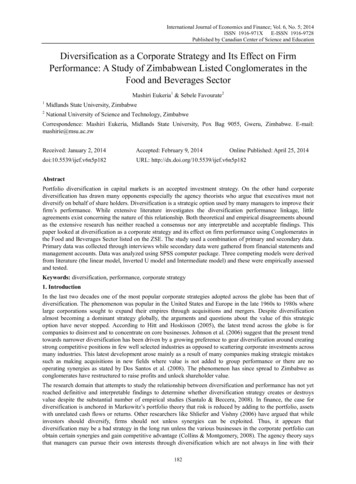
Transcription
International Journal of Economics and Finance; Vol. 6, No. 5; 2014ISSN 1916-971X E-ISSN 1916-9728Published by Canadian Center of Science and EducationDiversification as a Corporate Strategy and Its Effect on FirmPerformance: A Study of Zimbabwean Listed Conglomerates in theFood and Beverages SectorMashiri Eukeria1 & Sebele Favourate21Midlands State University, Zimbabwe2National University of Science and Technology, ZimbabweCorrespondence: Mashiri Eukeria, Midlands State University, Pox Bag 9055, Gweru, Zimbabwe. E-mail:mashirie@msu.ac.zwReceived: January 2, 2014Accepted: February 9, 2014Online Published: April 25, 2014doi:10.5539/ijef.v6n5p182URL: tfolio diversification in capital markets is an accepted investment strategy. On the other hand corporatediversification has drawn many opponents especially the agency theorists who argue that executives must notdiversify on behalf of share holders. Diversification is a strategic option used by many managers to improve theirfirm’s performance. While extensive literature investigates the diversification performance linkage, littleagreements exist concerning the nature of this relationship. Both theoretical and empirical disagreements aboundas the extensive research has neither reached a consensus nor any interpretable and acceptable findings. Thispaper looked at diversification as a corporate strategy and its effect on firm performance using Conglomerates inthe Food and Beverages Sector listed on the ZSE. The study used a combination of primary and secondary data.Primary data was collected through interviews while secondary data were gathered from financial statements andmanagement accounts. Data was analyzed using SPSS computer package. Three competing models were derivedfrom literature (the linear model, Inverted U model and Intermediate model) and these were empirically assessedand tested.Keywords: diversification, performance, corporate strategy1. IntroductionIn the last two decades one of the most popular corporate strategies adopted across the globe has been that ofdiversification. The phenomenon was popular in the United States and Europe in the late 1960s to 1980s wherelarge corporations sought to expand their empires through acquisitions and mergers. Despite diversificationalmost becoming a dominant strategy globally, the arguments and questions about the value of this strategicoption have never stopped. According to Hitt and Hoskisson (2005), the latest trend across the globe is forcompanies to disinvest and to concentrate on core businesses. Johnson et al. (2006) suggest that the present trendtowards narrower diversification has been driven by a growing preference to gear diversification around creatingstrong competitive positions in few well selected industries as opposed to scattering corporate investments acrossmany industries. This latest development arose mainly as a result of many companies making strategic mistakessuch as making acquisitions in new fields where value is not added to group performance or there are nooperating synergies as stated by Dos Santos et al. (2008). The phenomenon has since spread to Zimbabwe asconglomerates have restructured to raise profits and unlock shareholder value.The research domain that attempts to study the relationship between diversification and performance has not yetreached definitive and interpretable findings to determine whether diversification strategy creates or destroysvalue despite the substantial number of empirical studies (Santalo & Beccera, 2008). In finance, the case fordiversification is anchored in Markowitz’s portfolio theory that risk is reduced by adding to the portfolio, assetswith unrelated cash flows or returns. Other researchers like Shliefer and Vishny (2006) have argued that whileinvestors should diversify, firms should not unless synergies can be exploited. Thus, it appears thatdiversification may be a bad strategy in the long run unless the various businesses in the corporate portfolio canobtain certain synergies and gain competitive advantage (Collins & Montgomery, 2008). The agency theory saysthat managers can pursue their own interests through diversification which are not always in line with their182
www.ccsenet.org/ijefInternational Journal of Economics and FinanceVol. 6, No. 5; 2014shareholders. This complicates the case for diversification. It raises the debate of whom between the investor andcorporate executive should diversify.According to Thompson and Strickland (2006), “Diversification is a collection of individual businesses.”Diversification also allows companies to compete in an array of different businesses that may or may not berelated. Two seemingly irreconcilable facts motivate this study, one diversification continues to be an importantstrategy for corporate growth in the world over, Africa and in Zimbabwe and two while Management andMarketing disciplines favour related diversification, Finance makes a strong case against corporatediversification as pointed out by Brealey and Myers (2007, p. 946) when they argue that “diversification iseasier and cheaper for the stockholder than for the corporation”.Since the late 1990s and the early 2000s the desire for repositioning prompted listed companies in Zimbabwelike Delta, TA holdings and Innscor Africa to adopt diversification as a corporate strategy leading to the birth ofZimbabwean conglomerates. Now, diversification especially conglomeration has become a popular practice forZimbabwe’s firms to grow with the likes of Econet being the recent culprits acquiring TN Bank. The researchsought to establish why companies like Innscor Africa Limited and Delta corporation used diversification as acorporate strategy, when finance scholars such as Barney (2006) argue that “companies should stick to theircore competencies” suggesting that investors should diversify on their own and why some of them laterunbundled, with the likes of Delta corporation spinning four of its subsidiaries around 2001 which included OKZimbabwe, Pelhams and Zimsun hotels. The company later on went to acquire 29.8% of listed African Distillers,a related industry firm and then later 41.9% of listed Ariston Holdings- an unrelated business with interests inagriculture, any/dlta/ (22/08/13:14:00).Was the unbundling motivated by the costs of diversification exceeding the benefits, was it necessitated by areduction in corporate performance (conglomerate discount as described by Ozbas and Scharfstein (2010) orsome other factors? In making further acquisitions after unbundling, were the executives recreating the oldempire or safeguarding shareholders interests by diversifying? What impact did these strategies have oncorporate performance and shareholder value? The study sought to identify all forms of diversification employedby these conglomerates and evaluate their effects on firm performance.2. Literature Review2.1 IntroductionThere is still disagreement as to whether diversification increases or reduces performance, whether it causes aconglomerate premium or a discount respectively. The relationship is still controversial, contradictory andinconclusive. Questions still persist as to whether diversification strategy is universally profitable or universallyunprofitable. Thus the issue whether diversification improves or worsens firm performance is still worthy offurther research such as the one undertaken in this study. Besides, very little exists in terms of research in thearea of diversification and its impact on firm performance in Africa in general and Zimbabwe in particular. Thestudy sought to investigate diversification as a corporate strategy and examining the relationship betweendiversification strategy and firm performance using Zimbabwean conglomerates in the food and beverages sectorby asking a question initially posed by Villalonga (2004a) on the effect of diversification on firm performance,Diversification discount or premium? In the words of Santalo and Becerra (2009), the diversification–performance linkage is worthy of research since value creation has been put at the top of the objectives whichshould guide firm strategy.It is accepted that in developed economies investors can independently diversify their portfolios because moreefficient capital markets exist. As this is not the case in most of African states, the understanding of how internalcapital markets of diversified firms work is very important for policy makers as this would also assist them deteranti-competitive practices by big firms.2.2 When to Diversify and Motives for Diversifying?2.2.1 The Concept of DiversificationThe concept of diversification is yet to be clearly defined and there is no consensus on the precise definitionamong researchers. Apart from the definitions by scholars like (Turner, 2005; Thompson & Strickland, 2006;Aggarwal & Samwick, 2003), Johnson et al. (2006) says it’s a collection of businesses under one corporateumbrella. Lending support to all the various definitions, for this research diversification is defined in a broadsense as expanding business fields either to new markets, new products or both while retaining strong corebusinesses.Santalo and Becerra (2008) allude to the fact that a company can diversify when its cash flows become183
www.ccsenet.org/ijefInternational Journal of Economics and FinanceVol. 6, No. 5; 2014increasingly uncertain. Turner (2005) suggests that when the core business no longer offers the investor theacceptable returns for the risk taken, there is need to diversify. In the words of Barney (2006) if the core businessno longer offers growth opportunities, room for increasing sales and profitability then business should diversify.2.3 Diversification StrategiesDiversification strategies are used to expand the firm’s operations by adding markets, products, services or stagesor production to the existing business. Kotler (2006) identifies three types of diversification strategies namely,concentric, horizontal and conglomerate. “Horizontal Diversification strategy” occurs where a company seeksnew products that could appeal to its current customers even though the new products are technologicallyunrelated. “Conglomerate Diversification Strategy” takes place where a company seeks new businesses that haveno relationship with their present business or market operations (Thompson & Strickland, 2006).Collins and Montgomery (2005) divided diversification into two types related and unrelated diversification. Thetwo are analyzed in-depth, considering their merits and demerits whereas Emms and Kale (2006) describes thevarious ways and strategies adopted by diversifying companies as modes of diversification.Collins and Montgomery (2008) believe that related diversification involves building shareholder value bycapturing cross business strategic fits. The combining of resources creates new competitive strengths andcapabilities (BCG, 2006). Related diversification may involve use of common sales force to call on customers,advertising related products together, use of same brand names and joint delivery. On the other hand, Thompsonand Strickland (2006) believe that many companies decide to diversify into any industry or business that hasgood profit opportunities. Johnson et al. (2006) noted that in most cases companies that pursue unrelateddiversification nearly always enter new businesses by acquiring an established company rather than by forming astart up subsidiary. The basis for this strategy is that, growth by acquisition translates into enhanced shareholdervalue faster and the payback period is quicker.2.4 Risks and Rewards of Diversification as a StrategyThe corporate managers bring both a cost to the combined organizations as well as the opportunity to manage thecombined resources of the different businesses (Wan, 2011). According to Collins & Montgomery (2005), a moremeaningful approach is to analyse the costs (risks) and benefits (rewards) under the strategies of related andunrelated diversification.Hoechle et al. (2009) argues that the major advantages of related diversification are that it leads to operationalsynergies, which in turn develop into long-term competitive advantage. Johnson et al. (2006) argue that most ofthe advantages of related diversification stem from the fact that it allows the company to enjoy economies ofscope. Despite the above advantages related diversification can still fail to reap the originally predicted returnsand benefits due to several shortcomings and demerits. Gary (2005) allude to the fact that related diversificationanalysis at times underestimates the softer issues like change management, and may tend to overestimatesynergistic gains.The Boston Consulting Group (BCG) (2006), have noted that business risk is scattered over a set of diverseindustries and one can spread risk by spreading businesses with totally different technologies, competitive forces,market features and customer bases. This in line with the Markowitz portfolio theory in finance which suggeststhat diversification reduces a firm’s exposure to cyclical and seasonal uncertainties and risks. Dos Santos et al.(2008) also pointed out that a company’s financial resources can be employed to maximum advantage byinvesting in whatever businesses offering the best profit prospects.Campbell, Goold and Alexander (2006) identify that there is a big demand on corporate level management tomake sound decisions regarding fundamentally different businesses operating in different industries andcompetitive environments. This is often difficult to achieve where skills are not readily available which is true ofthe current Zimbabwean “brain drain” phenomenon. This was also echoed by Pindyck and Rubinfeld (2005). Onthe same line of thought Shliefer and Vishny (2006) argue that corporate managers have to be shrewd andtalented to run many different businesses.2.5 The Diversification- Performance RelationshipThe effect of corporate diversification on firm performance has been widely studied (Dimitrov & Tice, 2006;Yan et al., 2010; Hoechle et al., 2009; Hoskisson & Peng, 2005; Wan, 2011; Wright et al., 2005 and others).While this topic is rich in studies many researchers concurred on the lack of consensus on the precise nature ofthe relationship between diversification and firm performance. Some studies have shown that diversificationimproves profitability over time citing a positive relationship (Yan et al., 2010; Hoskisson & Peng, 2005; Wan,2011), whereas others have demonstrated negative relationship and that diversification decreases performance184
www.ccsenet.org/ijefInternational Journal of Economics and FinanceVol. 6, No. 5; 2014(Ozbas & Scharsfstein, 2010; Maksmovic & Phillip, 2007). Still others have shown that diversification andperformance linkage depends on business cycle. Santalo and Becerra (2004) explain conceptually and provideempirical evidence that no relationship exists (positive, negative or even quadratic) between diversification andfirm performance.Santalo and Becerra (2008), concurring with Stowe and Xing (2006), broadly conclude, (a) the empiricalevidence is inconclusive (b) models perspectives and results differ based on the disciplinary perspective chosenby the researcher and (c) the relationship between diversification and performance is complex and is affected byintervening and contingent variables such as related versus unrelated diversification, and mode of diversification.In the words of Daud, Salamudin and Ahmad (2009), studies in the areas have tended to provide inconclusiveresults due to inconsistent data, different time frames, different performance measures and moderate variables.Mackey (2006) argues that the contradictory results are related to; different timeframes, various measures ofprofitability and different measures of diversification. Andreou and Louca (2010) assert that the confusion ispartly methodological and partly theoretical. However, the diversification- performance puzzle was summarizedin the theoretical models outlined below as the theoretical framework is reviewed.2.6 Diversification and Shareholder ValueThe impact of diversification on shareholder value is mixed. Academics, consultants, the public and financialcommunity have different views. Some studies such as (Villalonga, 2004a, 2004b; Dos Santos, 2008; Doukas &Kan, 2006; Santalo & Becerra, 2008) have been aimed at establishing whether diversification leads toshareholder value destruction or improvement that is, either creating a discount or a premium. Some studies haveproved that high levels of diversification increase profitability and shareholder value (Dimitrov & Tice, 2006;Yan et al., 2010; Kuppuswamy & Villalonga, 2010). Villalonga (2004b) estimated the value effect ofdiversification by matching diversifying and single segment firms on their propensity score and found out thatdiversification does not destroy shareholder value. In the same direction Doukas and Kan (2006) pointed out thatsegments acquired by diversifying firms in most cases already traded at a discount before acquisition and hencetheir acquisition will improve performance, thus refuting the post acquisition negative relationship betweendiversification and performance in terms of profitability and shareholder value. Others have also shown that highlevels of diversification are detrimental to profitability and on average destroy shareholder value for diversifierspointing to the fact that refocusing generates positive shareholder returns. (Tongli et al., 2005). Masulis et al.(2007) found that firm characteristics which make firms diversify might also cause them to be discounted.2.6.1 Corporate Diversification Destroys Shareholder ValueThere is a school of thought among academic researchers, consultants, and investment bankers that diversifiedfirms destroy value (Ozbas & Scharfstein, 2010; Hoechle et al., 2009). The evidence that supports thisconclusion comes from a variety of sources. Diversified firms tend to have a lower Tobin’s Q; they trade at adiscount of up to 15%, when compared to the value of a portfolio of stand-alone firms; they face an increasedlikelihood of being broken up through reorganization that varies directly with the size of the discount; and thestock market tends to react favourably to increases in refocus (Collins & Montgomery, 2008; Masulis et al., 2007;Doukas & Kan 2006; Stulz et al., 2007). In line with this school of thought Breadley et al argue that companiesshould stick to their core competencies and let shareholders diversify on their own as diversification is costlyrather than beneficial for the corporation. The author states that poor multidivisional performance destroys value.Doukas and Kan (2006), point out the problem of capital misallocation in diversified firms as the one of thereasons for poor performance.2.6.2 Corporate Diversification Creates Shareholder ValueDespite researchers like Ozbas and Scharfstein (2010) concluding that diversification is not a successful path tohigher performance because the value of the diversified firm is less than the sum by an average discount factor of13–15%, others like Akbulut and Matsusaka (2010), Kuppuswamy and Villalonga (2010), Dastidar (2009) argueagainst the diversification discount and point to a premium. The researchers found empirical evidence thatdiversification might be a value enhancing strategy. Dimitrov and Tice (2006) assert that there is nodiversification discount and in fact diversified firms trade at a significant premium.In the words of Yan et al. (2009), “corporate diversification becomes more efficient and value adding wherecapital markets are relatively inefficient and various segments of a diversified firm would be financiallyconstrained as single segments hence diversified firms would create shareholder value as compared to singlesegments”. Kuppuswamy and Villalonga (2010) find that relative value of
strategy for corporate growth in the world over, Africa and in Zimbabwe and two while Management and Marketing disciplines favour related diversification, Finance makes a strong case against corporate diversification as pointed out by Brealey and Myers (2007, p. 946)



